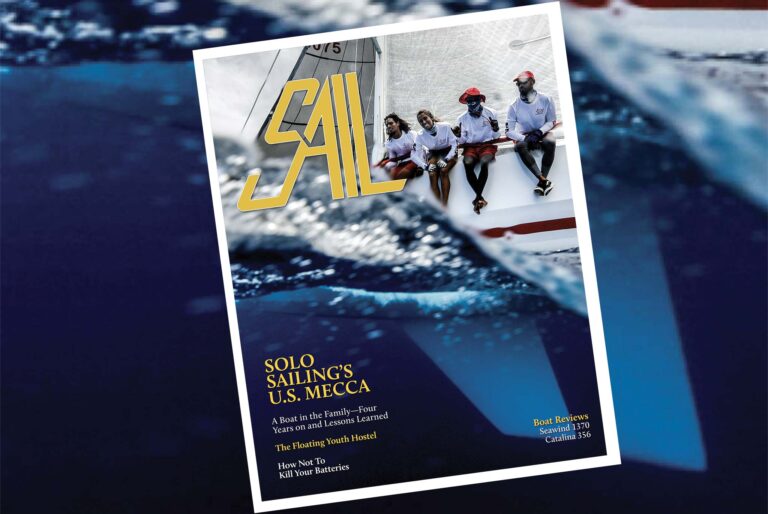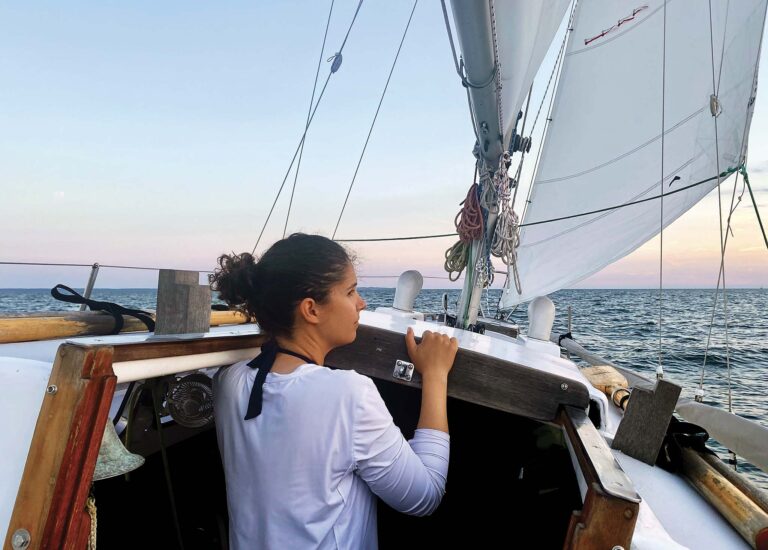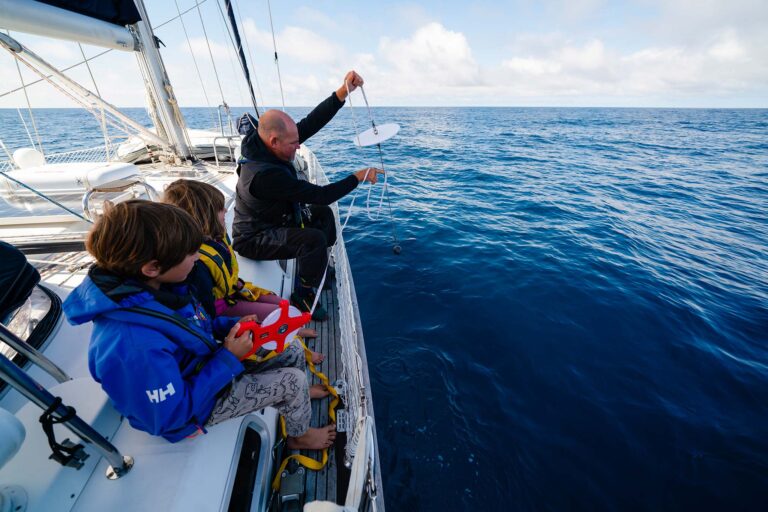
It had been calm when I went to sleep, a calm that was supposed to have lasted into the next day. But by 0300 it was blowing hard from the northeast and Hope, my Seaward 22, was tugging at her anchor.
I was at the western end of Lake Erie, lying uneasily behind a spit of Canadian sand called Pelee Point. It was too precarious a place to stay in a rising breeze. I had two choices: find my way in the dark into an unfamiliar marina about eight miles away or head to my home port, Ohio’s Huron River, 32 miles across the lake.
The weather forecast steered my decision toward Huron, with the promise of northeast winds gradually building to 10-20 knots in the afternoon giving me an easy broad reach home. I would be off the water long before the heavy weather arrived later that evening. Or at least, I would have if the forecast were true.
In fact, even before I got underway there was already far more wind than there should have been. Steering by compass in the starless night, I guided Hope out from behind the shelter of Pelee Point and found Erie’s notorious temper beginning to flare. It’s a shallow lake, so steep and dangerous waves build quickly: one of the reasons for the 2,000 or so shipwrecks lying beneath Erie’s surface. I, therefore, set just the working jib—no mainsail—put my life jacket on and clipped in my harness, and was soon glad I had, as I quickly found myself in the middle of a Great Lake, in the middle of the night, in the midst of a gale.
Immediately, it became a struggle to steer a safe path through the black waves, taking the crests a few degrees off the stern, then heading up in the troughs. The wind howled through the rigging, and spray and rain pelted me, getting in my hood and down my neck. It was early May, with the air and water temperature both around 50 degrees, and I was soon shivering, despite the thick layers under my foulweather gear. I tried not to think about my survival time if things went wrong and I ended up in that cold water.
I also had a handheld VHF radio onboard for emergencies, but it was unwisely stowed below instead of clipped to my belt. Anyway, in those days it was doubtful a call from the middle of the lake on a handheld would be heard by anyone on shore anyway, including the Coast Guard. There was nobody on the water but me.
About midway between Canada and the United States in the gray dawn, I turned my head to see an immense breaker towering over me. In all my years of sailing the Great Lakes, I had never seen anything like it, never believed these waters could breed such a monster. I desperately lined up the stern before we were overwhelmed, but it was no use. The heaving mass lifted my helpless craft and threw her sideways. I clung to the stern pulpit as we went beyond 90 degrees, free-falling down the face of the wave. Time slowed, and I was sure that disaster awaited when we hit bottom. The boat was not designed to endure this kind of punishment. Would my vessel right herself again? Would she be dismasted? Would the hull even hold together?
We slammed into the trough, and I braced myself expecting to capsize. But to my astonishment, Hope refused to go under. Slowly, almost painfully, she righted herself, regained her balance, and we turned and ran again toward home.
After this, I was ever more watchful of the waves, but at the price of being less careful about keeping to some semblance of the course, I had drawn on my chart. During our passage, the islands of Lake Erie had occasionally been visible through the rain far off to leeward, but I hadn’t been able to take bearings and plot my position. I carried no electronics for navigation—only paper charts.
As I began to intermittently glimpse the rollercoasters of the Cedar Point amusement park in Ohio, I realized we were off course, and that I needed to head east or else we would hit land where there was no safe harbor. Unfortunately, the lake was now largely dictating our direction, driving us relentlessly shoreward. I tried heading up some more in the troughs, striving for sea room, hoping to get far enough east. But it wasn’t enough.
By the time I could make out the light marking the entrance to the Huron River, I knew we would be pushed onto the coast a mile or two short if I kept my present course. Even worse, the Huron River has a breakwater that juts into the lake perpendicular to the shore, and we were heading into a trap on the wrong side of it. My options were down to one: I would have to abandon the sensible storm tactic of taking the waves on the stern and turn to face them head on. I doubted we could even do it. Nonetheless, I started the outboard to help us drive to windward, waited for the right moment between waves, then turned.
At first, the power and fury of the lake seemed more than we could fight our way through, but fight we did, battling our way through endless cliffs of crashing water. Gradually, almost imperceptibly, we began to win ground. Until suddenly, the motor went silent.
I threw it in neutral and pulled on the cord. Nothing. I checked the fuel tank and fuel line, all while trying to steer, but found nothing amiss. Meanwhile, we were swiftly being driven backward into shoal water, and in a matter of minutes were being tossed in the surf. It was then I saw that the jib halyard, which I had previously coiled and secured, had come loose and was now wrapped around the propeller. My heart sank. Without the outboard’s help, the looming erosion control boulders of a lakefront home would be our destination. I gave a silent plea and tugged the line. It came loose! I threw it in the cockpit and pulled the outboard back to life. By now, though, our situation was truly dire—alteady in the surf and just a few hundred feet from the rocks.
Desperately, we clawed our way into the wind and waves, heeling and rocking at crazy angles. The outboard slowed and raced, slowed and raced, as the prop lifted in and out of the water. With every tack we lost almost as much ground as we had just made. The gale had ripped the batten in my self-tending jib out of its seams, leaving a misshapen, flogging sail. My poor boat shook and shuddered with the pounding, but there was no alternative. Waves crashing and exploding halfway up the nearby lighthouse showed the violence that would overtake us if we went on the rocks.
I spent two and a half hours in that sailor’s nightmare, battling Lake Erie’s full fetch and force, struggling to work no more than a mile to windward. But in the end, we made it, fighting our way around the breakwall and into the safety of the river.
When we reached the marina, well upriver, I found a minor disaster zone. The floating docks had dragged, and there were now a number of boats banging into each other. But I was too exhausted to care. I tied up in one of the least damaged areas and staggered out onto land, barely believing I had made it.
What I did right:
• I had a harness and life jacket on and the hatches secured before setting out.
• I erred on the side of caution and put up far less sail to begin with than I could have. I did not have reef lines or halyards led aft to the cockpit, so this saved me the nightmare of going forward to reef in bad conditions.
• I had just re-read Adlard Coles’s Heavy Weather Sailing before the trip, and I felt my storm tactics were well executed and fit the circumstances.
What I did wrong:
• My foulweather gear was inadequate for the conditions.
• I should have had better means of communication in the event of an emergency.
• Since I was single-handing, all lines should have been led aft to the cockpit and more thoroughly secured. When faced with a lee shore, I couldn’t leave the helm to change my sail configuration and so was forced to sail to windward with only a jib up. (Although in this particular situation, even my double-reefed main would have been too much sail.)
• I should have been more skeptical about what turned out to be a very inaccurate weather forecast, and more willing to trust my own instincts.
• I should have allowed myself more sea room in order to hit the narrow river entrance. I let my concern over another knockdown override the danger of a lee shore. This was my biggest lapse of judgment.
Dale Piper has been sailing the Great Lakes for over 30 years in everything from one-design dinghies to 35ft cruisers. A retired librarian, he lives with his wife in the Cleveland, Ohio area.
May 2018









